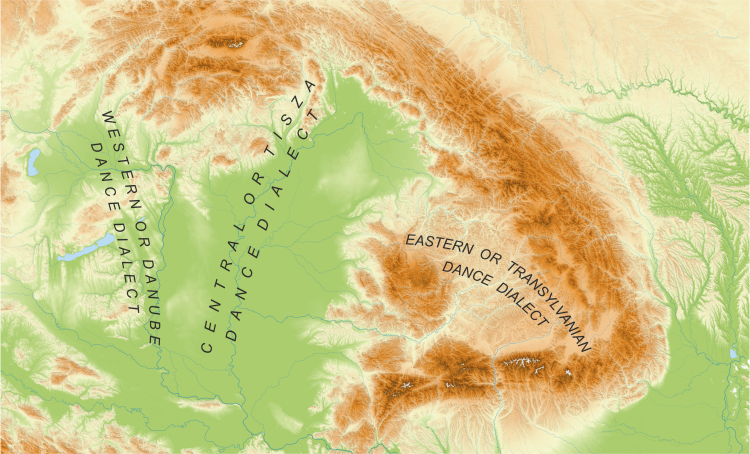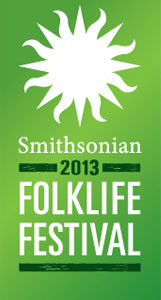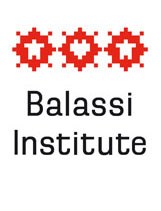by László Felföldi
The folk dance traditions of the Hungarians in the Carpathian Basin have a uniform picture. At first glance, there are no striking differences between the traditional dances of Rábaköz (Northwest Hungary), the Upper-Tisza Region (Eastern Hungary) and the Székely Land of Transylvania (Present day Romania). Similar dances types are found within all regions: men’s solo dances, older and newer forms of couple dances, and various forms of circle dances. From an ethnographer’s perspective, however, these three regions can be broken up into 50 smaller regions. The three main folk dance dialects can be broken up into: Western (Danube), Central (Tisza) and Eastern (Transylvania) regions.

The Western (Danube) dance dialect includes the territories: the Dunántúl Transdanubian Region [Slavonia, Drava, Lendva, Burgerland, Csallóköz, Mátyusland, and Zobor region], Northwestern Palóc Region and the area between the Duna and Tisza rivers. The unique characteristics of this region are the archaic shepherd dances using props (such as sticks) and jumping dances, the women’s circle dances accompanied by acapella singing, and the occurrence of round recruiting dances. The csárdás is considered to be a newer dance type, using down-beat accented movements and have significant differences between the slow (‘lassú’) and the fast (‘friss’) csárdás. Traditional weddings and festivals which include traditional folk customs are still common, for example, the bride-laying candle-dance, girls’ Pentacost (‘Pünkösd’) procession accompanied by singing (‘pünkösdölő’), and the lad inauguration (‘legényavató’) dance rituals.
| [Video not found] | [Video not found] | [Video not found] | [Video not found] |
| Karikázó Őcsény, 1973.04.21. MTA Ft. 0816.02 |
Kanásztánc Alap, 1973.04.24. MTA Ft. 0819.05 |
Seprűtánc Madocsa, 1968.05.12. MTA Ft. 0624.06 |
Páros kanásztán Berzence, 1981.11.20-22. MTA Ft. 1112.52c |
The Central (Tisza) dance dialect includes the traditions of the central part of the Hungarian-speaking region. This region spans from Gömör and Zemplén up to the lower-Tisza region, and the Eastern mid Danube and Tisza Rivers to east of the Tisza River (‘Tiszántúl’). The dance traditions of this region are more unified than the traditions of the other two. We notice a slight deviation in the Uplands (Felvidék) since the Turkish occupation did not effect this area, as compared to the regions of the boroughs of the Great Plains (Alföld). Unique features of the upper Tisza region are, for example, the skillful shepherd’s stick dance, the solo recruiting dances and the spring women’s dances. A unique contrast is seen by the presence of the jumping dances which occur mainly in the Southern and Eastern part of the Great Plains. In this region the csárdás is characterized by an up-beat accented movement, and there are no significant differences between the slow (‘lassú’) and the fast (‘friss’) csárdás. The wedding row-dance, the dawn fire-dance, and the ‘lad’s funeral dance’ performed at the wedding (symbolizing the death of this youth) are the unique customs of this region.
| [Video not found] | [Video not found] | [Video not found] | [Video not found] |
| Botoló Nyírvasvári, 1975.09.07. MTA Ft. 0894.20 |
Pásztorbotoló Nagydobos, 1955-56 MTA Ft. 0249.06 |
Magyar verbunk Nagyecsed, 1968.08.20. MTA Ft 0640.01 d |
Karikázó Nyíri, 1973.08.18. MTA Ft. 0825.02 |
| [Video not found] | [Video not found] | [Video not found] | |
| Oláhos Tápé, 1952.03.09. MTA Ft. 0154.03 |
Csárdás Nagyecsed, 1968.08.20. MTA Ft. 640.2 |
Hármas csárdás Geszteréd, 1955.12.17. MTA Ft. 0281.14 |
The Eastern (Transylvanian) dance dialect includes the Csángó people from Gyimes of the Carpathian Mountains, the Szeklers (székelyek) of Bukovina and the Csángó-Hungarians of Moldva. Though there are differences between them, their dance traditions spring from the same Transylvanian roots. The dance culture of this region is characterized by the predominance of revolving couples dances and solo male dances. In contrast to the other two regions mentioned above (Western and Central), the acapella female circle dances and the instrumental shepherd dances are not present. A unique feature of this region is the winter Csángó ‘borica’-dance of Hétfalu (literal translation, ‘Seven Village’) in which the houses of the village were visited by groups of men who presented their traditional men’s dance with masks and painted paddles. The outstanding feature of the Csángó people’s folk culture is the fact that their dances, music and traditions were preserved in an authentic form to this day. This is attributed to the presence of the virtuosic string-musicians, the strong following with the unique dance, and the geographical and cultural conditions of the region.
| [Video not found] | [Video not found] | [Video not found] | [Video not found] |
| Forduló Vajdaszentivány, 1990.07.22. MTA Ft. 1363.01 |
Lassú és gyors csárdás Türe, 1969.04.11. MTA Ft. 690.43 |
Pontozó Lőrincréve, 1968.06.09. MTA Ft. 0625.01 |
Lassú magyaros Sötétpatak, 2003.10.24. HH 1184110 |
| [Video not found] | [Video not found] | ||
| Sima héjsza Gyimesközéplok, 1980.08.02. MTA Ft 1063.08 |
Kerekes Gyimesközéplok, 1980.08.02. MTA Ft 1063.18 |
Hungarian folk dance traditions is categorized not only by categories by regions but also can be divided into ‘historical’ stylistic layers. Based on folk dance historical sources (pictures, texts, field recordings and music history), older and newer layers can be delineated within the dance culture of the Hungarian-speaking regions. The characteristic dance genres of the older style, which dates back to the Middle Ages, are the shepherd’s dances using props, the jumping dances, the acapella female circle dances and the archaic couple-type dances which preceded the csárdás. The representatives of the new style in our dance traditions, which first appeared at the end of the 18th century to the first half of the 19th century, are the recruiting dance (‘verbunk’) and the csárdás.






